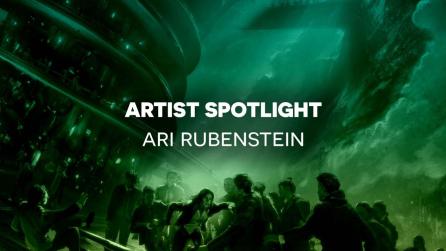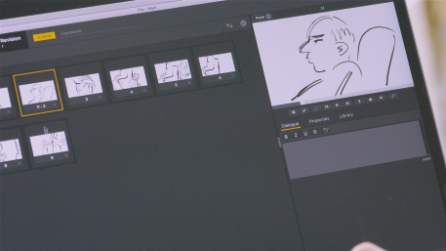Confessions of CoSA VFX: guilty of creating award-winning episodic content.
Imagine a technologically-advanced Wild-West themed amusement park as part of a dystopian universe. This park is populated by android ‘hosts’ who are trying to solve a murder that happened a decade ago. The hosts have joined forces with an eighteen-year-old human and a crash-landed alien so they can untangle the circumstances of this mysterious murder and set traps for the culprit.
You may now think this is the premise of a show you have never watched before. And you’re right to believe so—this narrative is a mix-and-match storyline of three well-known television series: Westworld, Nancy Drew and Resident Alien.
CoSA VFX is no stranger to the demands of episodic content and managed to juggle these episodic projects, amongst many others, and create high-quality visual effects for all of them. They grew from four founders to hundreds of artists and shared with us that their mission statement was and still is to “create a stable, empowering community where gifted people produce excellent visual effects in an environment of uncompromising professionalism, integrity, kindness, and respect,’’ Mark Nazal, Director of Digital Content, shares with us.
It looks like their mantra was fruitful. Their outstanding work brought them multiple VES and Emmy nominations and the Outstanding Special Visual Effects and Outstanding Special Visual Effects in Supporting Role awards in 2017 for their contribution to Westworld and Gotham respectively. From shows like Lucifer which allowed them to “spread their wings further’’ to Person of Interest which left them with “fond memories’’ and Swamp Thing where they ”delved into creature work’’, CoSA VFX managed to build, brick by brick, show after show, a powerful wall of expertise.
We caught up with Eduardo Arroyo, Compositing Supervisor on Resident Alien, Ryan Bauer, Compositing Supervisor on season three of Westworld, and Francisco Palomares, Compositing Supervisor on season three of Nancy Drew, along with Kama Moiha, Head of 2D.
CoSA VFX recipe
There’s no perfect recipe for tackling challenges but, armed with Nuke, the team at CoSA VFX was able to come up with a plan to dismantle the obstacles so often faced when working on episodic content such as rapid production schedules and tight timelines.
“We do this by understanding the scope of the work and ensuring clear communication with the clients. This is followed by an assessment of the tools required and supervisory assignments in CG and Compositing groups to determine the teams that are the best fit to work on the show(s). Furthermore, apart from looking at internal resources, we also evaluated the need for outsourcing to aid with additional support based on schedules and volumes,’’ Kama Moiha tells us.

The setup and workflow of every studio are key components in the creative process. A fundamental aspect of the studio set up in their compositing teams is maintaining the integrity of the plate by sending the client back renders similar to the plates received. Their color workflow is automated to convert CDLs (color decision list) into a Viewer LUTs (Lookup Table) that they use as references in Nuke while keeping the linear plates intact.
But having a plan of the setup and the workflow also requires a robust set of tools that can support its steps. And that’s why CoSA VFX added Nuke Studio to their bag of tricks, Foundry’s powerful package for multi-shot management, editorial, compositing and review.
“We started using Nuke Studio more broadly around 2017 after the development of custom pipeline tools to make our workflows more efficient,’’ Kama Moiha tells us. “It fits into our pipeline as more of a QC tool for the Compositing Supervisors to keep track of various sequences on their shows.’’
The custom tools they have created in Nuke Studio allowed them to automatically load in sequences, LUTs, transforms, and more which were then used to create tracks for the supervisors to compare the final product against the original footage and the references that the client provided.
The teams also utilized Nuke Studio to its full potential to ensure they were working on the correct shot lengths, adding post moves or resizes to shots that the editors had previously put together. For larger portions of work on certain episodic projects, there were many shots and complicated sequences, and so Nuke Studio was used to ensure the teams were keeping the consistency of their effects.
Androids, an alien and a mysterious murder
You couldn’t get three more diverse shows, and yet, CoSA VFX nailed them all. From creating CG shots of aliens to manufacturing android host bodies and rats or moths. We went on a case-by-case basis and sat down with three Compositing Supervisors at CoSA VFX as we wanted to see what their experience was when creating these bizarre elements. Let’s find out together!
Resident Alien gave the compositing team the opportunity to expand their work on Lucifer and work with the first CG lead character in a comedic project. Eduardo Arroyo shares with us his experience of working on this show:
“This is a very creative show with all kinds of visual effects. It could range from something as small as a wire clean-up to something as big as a full CG shot with spaceships/aliens/environments. This is definitely one of the most creative shows I have worked on.’’

His work on this show was a long journey as he contributed to the majority of the season. And during this journey, Nuke Studio came to the rescue when challenges started to arise:
“Nuke Studio was definitely useful when it came to reviewing long sequences. We used it quite a lot for our alien enhancement shots, for sequences reviews, and to ensure the quality, continuity, and color between shots were looking great and working well.’’
Similarly, working on Nancy Drew was also about demolishing any creativity barriers and embracing diversity in all its mesmerizing nature. For Francisco Palomares and his team, Nancy Drew brought a variety of intriguing shots to work on: “they ranged from set extensions and CG environments to screen inserts, from creatures like rats and moths to creating fires or steam, blue screens, of course, and some Magical or Fantasy effects. Nancy Drew is a joy in that regard.’’
The largest sequence to date was working with a tsunami sequence that engulfs the whole town and it was quite a feat to accomplish this large-scale visual effects sequence on a compressed television timeline.
The particularity of this project was its anamorphic aspect but that didn’t make the team wobble. They guarded their streamlined workflow by using both Hiero, our powerful creative editorial review tool, and Nuke Studio. If a shot was anamorphic, they rendered everything in anamorphic.
“If a shot was spherical—as many were—the comp would take place in the spherical plate and then be converted to anamorphic at the end of the comp,’’ Francisco added. “If we ran into any issues, they were more creative than technical but we have the knowledge and expertise to make the shots look good and the client was happy with the results.’’

This show was the first one when Francisco used Hiero and he expands on his experience of using it: “I was surprised to see how intuitive and clean it is. I use it only to review shots in continuity but color and playback was solid, I didn’t have any hiccups.’’
Francisco started working on Nancy Drew later in the show and, similarly, Ryan Bauer jumped on Westworld as a Compositing Supervisor on its third season. “Initially, I found a certain amount of challenge in catching up on a sort of established language the show had developed over the previous two seasons,’’ she tells us.
How did she catch up though? First, she had to learn the visual style that the showrunners often gravitated towards. She then used the examples from previous seasons and the experiences of her colleagues in order to anticipate what kinds of looks they might like to see for newer effects.

The compositing team worked on every episode of season three. The number of shots was always unpredictable, as well as the effects count. They were working on certain effects and the absence or abundance of those effects in any given episode would drive how much they would have to handle.
Ryan explains: “some of our primary effects included the Rehoboam/Soloman elements, close-up manufacturing of host bodies, the Sublime and Sweet Water environments, as well as several VR/AR digital effects—whether they were contacts, glasses, holograms or digital glitching.’’
To the future
CoSA VFX is a truly inspiring studio in the VFX arena. But what brought them here? Their mantra? Their unique workflow? The way their compositing teams deal with the typical challenges in episodic projects? Maybe all of these, along with their creativity, expertise and practical experiences on unique episodic shows. One thing is for certain, we’re excited to see their amazing VFX touch on future episodic projects.




